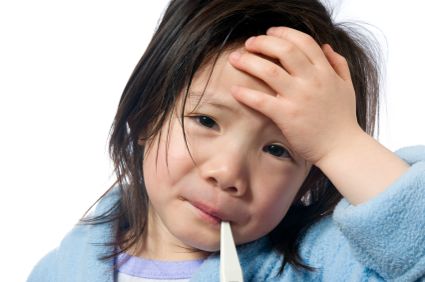Fever in Children:
When to worry and when to relax
By Shilpa Vernekar, M.D., F.A.A.P.
Every parent can relate to that feeling of worry and even a hint of panic that come along with symptoms of illness in your child and a raised thermometer reading; anything above 98.6 ° F or whatever your child’s normal body temperature registers, can motivate many moms and dads to jump right into the car and head to the doctor. However, while your pediatrician always loves to see your family, many times that trip to the office just isn’t necessary.
At Preferred Medical Group, we strongly feel that parents should have all of the facts related to fever in children in order to make a determination about whether or not a doctor’s visit is needed. Here are a few tips about identifying fever, bringing fever down, and knowing when to call on your child’s pediatrician for backup.
What is fever?
Body temperature of more than 100.4 ° F or 38 ° C is considered to be fever.
Why does my child get fever?
Fever is a normal body response to fight against infections. Whenever the body recognizes there is an illness caused by bacteria, virus or other organisms, the body temperature raises to help fight off the infection. So, fever is a good thing for your child. It shows that the body is mounting an immune response to curb the illness.
When should I be worried?
This can depend on the age of your child. Any temperature of more than 100.4 ° F in a neonate (less than 28 day old) is concerning, and medical attention should be sought immediately. Between 1 and 3 months, it is important to have the patient checked out by a physician when body temperature rises above 100.4 ° F.
 Other symptoms warrant seeking immediate medical attention in a feverish child irrespective of age, including: seizures, altered mental status, severe headache with neck stiffness, and difficulty breathing.
Other symptoms warrant seeking immediate medical attention in a feverish child irrespective of age, including: seizures, altered mental status, severe headache with neck stiffness, and difficulty breathing.
If the child is currently on chemotherapy, has compromised immune system, has sickle cell disease, or if the temperature is more than 105 ° F, take your child to a physician at once.
If your child is healthy, behaving his usual self and does not have any underlying disease or condition, the child can be monitored for symptoms. In the meanwhile, administer a weight-appropriate dosage of Tylenol/Motrin to help reduce the fever.
(To calculate a weight-appropriate dosage for your child, please visit our website www.preferredmedgroup.com and click on our Phenix City Children’s office. The dosage calculator at the bottom right-hand corner will allow you to input your child’s age, weight and the concentration of the medication to determine how much to safely administer.)
Tylenol is recommended if your child is less than 6 months of age.
Please know that it is normal for children to act clingy, become picky eaters or eat less than normal when they have fever. It is part of the illness and will improve as they get better. You can be reassured if the child is drinking and is acting more or less like his usual self. Severity of the illness does not correspond with the body temperature. Most viral illness can cause temperatures as high as 104 ° F.
How to measure temperature?
It is very important that body temperature should not be estimated and always should be accurately measured with a thermometer. Temperature check by touch or visual appearance such as paleness or flushed cheeks should not be used as a means to assess increased body temperature, as these are not reliable indicators of whether or not fever is present.
There are various types of devices available to measure temperature. Digital thermometers are very easy to read and are very reliable. If the child is less than 3 months, temperature is best measured rectally. After the child is more than 3 months, temperature can be measured orally or axillary.
What to do if my child’s temperature is greater than 100.4 ° F?
- Administer Tylenol or Motrin at a weight-appropriate dosing. (Again, please see the Phenix City Children’s page of our website for a dosage calculator.) Studies have shown alternating Tylenol or Motrin does not provide an additional advantage, so one can safely stick to either one of the drugs.
- Let the child eat or drink as per preference. No dietary restrictions are necessary unless advised otherwise. Just ensure that the child stays well hydrated.
- Avoid contact with other children if possible.
- Make sure the child is comfortable, dressed in light clothing and the room temperature is neither too hot nor too cold.
- If there are no symptoms as mentioned earlier that would cause immediate need for medical treatment, observe for other symptoms other than fever and overall appearance of the child—(ie his mental status, his breathing, appetite and usual behavior.). If any of the above-mentioned symptoms do appear, seek medical attention.
- If the child has no underlying medical conditions and the temperature is greater than 102 ° F for more than 2 days, please call your physician’s office.
Parents, please rest assured that fever can be a good thing while your child’s body is fighting an illness and can often be treated at home with Tylenol/Motrin. However, please keep in mind that the advice contained in this blog are general guidelines for fever in children. You and your child’s pediatrician know your child best, and if you see signs that your child needs medical attention that may not appear in this blog, please do not hesitate to call the doctor’s office. Most physicians have nurses available to speak to parents on the phone to triage your child’s symptoms and to help you determine if a visit is necessary.
Dr. Vernekar, M.D., F.A.A.P. is a board-certified pediatrician who works at Preferred Medical Group, which has locations at Phenix City Children’s and Fort Mitchell Clinic. Her special areas of interest include weight management and nutrition.



